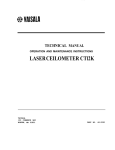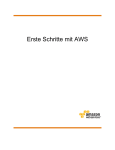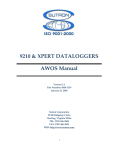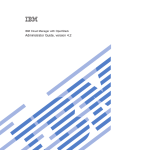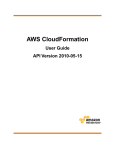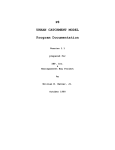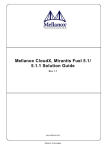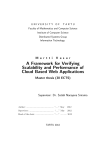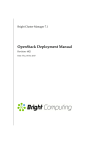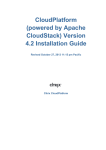Download Deployment of Virtual Resources Using Template Management
Transcript
International Journal of Science and Research (IJSR)
ISSN (Online): 2319-7064
Index Copernicus Value (2013): 6.14 | Impact Factor (2013): 4.438
Deployment of Virtual Resources Using Template
Management Technology on Openstack
S. L. Mani Deepu1, Hemavathi D2
1
M. Tech Cloud Computing, Department of Information Technology, SRM University, Kattankulattur, Chennai, Inda
2
Assistant Professor (Sr.G), Department of Information Technology, SRM University, Kattankulathur, Chennai , India
Abstract: This Paper actually focuses on the development of template management technology to build virtual resources environments
on openstack. We have technologies which deploy a set of virtual resources based on system environmental templates to enable easy
building expansion or migration of cloud resources. Openstack heat and Amazon cloud Formation are template deployment
technologies and build stacks which are set of virtual resources based on templates. These existing technologies have some problems
.Heat and CloudFormation transaction management of stack create or update are insufficient Heat and CloudFormation do not have
sharing mechanism of templates .Heat Cannot extract templates from existing environments. Heat does not change reflect the actual
environment changes to stack information. The goal of this to create a template management technology with necessary improvements.
It has a mechanism of transaction management like rollback in case of abnormal failures during stack operations. It shares templates
among end users and system integrators. It extracts templates from existing environments.
Keywords: OpenStack, Template management server, Heat, Cloud Formation, Iaas
1. Introduction
Cloud computing technologies such as virtualization and
scale-out have been progressed and many other providers
have started cloud services. Iaas service provides hardware
resources of cpu via network. openstack is one of the major
opensource Iaas software and adoptions of opensource Iaas
software is increasing. With a wide spread of cloud services,
technologies which deploy a set of virtual resources based
on system environmental templates to enable easy building,
expansion, migration of cloud virtual resources have
emerged. For example, openstack Heat and Amazon
CloudFormation are template deployment technologies and
build stacks which are sets of virtual resources based on
templates.
Heat
and
CloudFromation
transaction
managements of stack create and update are insufficient.
Heat and CloudFormation do not have sharing mechanism of
templates .Heat Cannot extract templates from existing
virtual envionments. Heat does not reflect the actual
environment changes such as virtual environment changes,
such as virtual machine deletion by openstack nova API.
The openstack project is a platform for developing,
deploying and hosting cloud computing solutions using open
source software. OpenStack is an open source infrastructure
as a service (IaaS) initiative for creating and managing large
groups of virtual private servers in a cloud computing
environment. The primary objective behind openstack
project is to create a global standard and software stack for
developing cloud solutions helping cloud providers and endusers alike. The project aims to build a unanimous cloud
operating platform, where all the participating organizations
will build cloud solutions that are not only scalable ,elastic
and secure but also globally accessible OpenStack Heat, the
orchestration service that allows you to spin up multiple
instances, logical networks, and other cloud services in an
automated fashion. some basic terminology.
Paper ID: SUB153556
Stack: In Heat parlance, a stack is the collection of objects
that will be created by Heat. This might include instances
(VMs), networks, subnets, routers, ports, router interfaces,
security groups, security group rules, auto-scaling rules,
etc.
Template: Heat uses the idea of a template to define a
stack. If you wanted to have a stack that created two
instances connected by a private network, then your
template would contain the definitions for two instances, a
network, a subnet, and two network ports. Since templates
are central to how Heat operates.
Parameters: A Heat template has three major sections,
and one of the sections defines the templates parameters.
These are tidbits of information-like a specific image
ID,or particular network ID-that are passed to the Heat
template by user. This allows us to create more generic
templates that could potentially use different resources.
Resources: Resources are the specific objects that Heat
will create and/or modify as part of its operation, and the
second of the three major sections in a Heat template.
Output: The third and last major sections of a Heat
template is the output, which is information that is passed
to the user ,either via openstack Dashboard or via the heat
stack-list and het stack-show commands.
HOT: Short for Heat Orchestration Template .HOT is one
of two template formats used by Heat. HOT is not
backwards-compatible with AWS CloudFormation
templates and can only be used with openstack. Templates
in HOT format are typically but not necessarily expressed
as YAML.
CFN: Short for AWS CloudFormation, this is the second
template format that is supported by Heat.CFN-formatted
templates are typically expressed in JSON.
Architecturally, Heat has few major components:
The heat-api component implements an openstack-native
RESTful API.This components processes API requests by
sending them to the Heat engine via AMQP.
Volume 4 Issue 4, April 2015
www.ijsr.net
Licensed Under Creative Commons Attribution CC BY
2247
International Journal of Science and Research (IJSR)
ISSN (Online): 2319-7064
Index Copernicus Value (2013): 6.14 | Impact Factor (2013): 4.438
The heat-api-cfn component provides an API compatible
with AWS CloudFormation and also forwards API
requests to the Heat engine over AMQP.
The heat-engine component provides the main
orchestration functionally
OpenStack Architecture
All of these components would typically be installed on an
openstack “controller” node that also housed the API servers
for Nova, Glance, Neutron, etc. Heat uses a back-end
database for maintaining state information.
Figure 2: OpenStack Architecture (Single Node)
Figure 1: A Basic Implementation of the Concept
2. Outline of openstack
Openstack, CloudStack and Eucalyptus are major
opensource Iaas software, and among them openstack
community is active because many providers contribute
developments and adopted services rapidly increasing.
openstack is composed of the function blocks which manage
logical/virtual resources deployed on physical resourcs, the
function block which provides single sign on authentication
among other function blocks and the function block which
orchestrates a set of virtual resources. Neutron controls
virtual networks.OVS(Open Virtual Switch) and other
software switches can be used as a virtual switch. Nova
controls virtual machines KVM(Kernel virtual machine) and
others can be used as hypervisors of VMs.Cinder manages
the block storages and can attach a logical volume to a VM
like a local disk.Swift manages object storages Glance
manages Image files. Keystone is a base which performs
single sign on authentication of these function blocks. Heat
is an orchestration deployment function to create or update
virtual resources instances using Nova, Cinder or other
blocks based on a text template.celiometer is a metering
service of virtual resource usage. The functions of openstack
are used through REST(Representation State Transfer)
APIs.There is also web GUI called Horizon to use the
functions of openstack.
Problems in Existing Template Technologies
Openstack Heat and CloudFormation are technologies which
deploy a set of virtual resource instances based on templates
which contain information of virtual resource environment
and are described by JSON,YAML or other text format
.Both call a set of virtul instances which are deployed based
on template “stack” and provide API’s to operate stacks.
However, these API’s provide primitive CRUD (Create,
Read, Update, Delete) operations of stack and there are
some insufficient points for business use.
Paper ID: SUB153556
OpenStack version used here for the Design of the project is
Juno Update on top of Ubuntu 14.04(Trusty Tahr).[3].
OpenStack is a collection of open source software projects
that enterprises/service providers can use to setup and run
their cloud compute and storage infrastructure. Rackspace
and NASA are the key initial contributors to the stack.
Rackspace contributed their "Cloud Files" platform (code) to
power the Object Storage part of the OpenStack, while
NASA contributed their "Nebula"platform (code) to power
the Compute part. OpenStack consortium has managed to
have more than 150 members including Canonical, Dell, and
Citrix etc. Heat is the main project in the openstack
orchestration program. It implements an orchestration
engine to launch multiple composite cloud applications
based on template in the form of text files that can be treated
like code. A native template format is evolving, but Heat
also endeavours to provide compatibility with the AWS
CloudFormation templae format, so that many existing
CloudFormation templates can be launched on openstack.
Heat also provides an autoscaling service that integrates with
ceilometer, so you can include a scaling group as a resource
in a template.
Figure 3: Data Flow in OpenStack
There are main service families in OpenStack Juno:
Nova - Compute Service
Swift - Storage Service
Glance - Imaging Service
Keystone - Identity Service
Neutron - Networking service
Cinder - Volume Service
Volume 4 Issue 4, April 2015
www.ijsr.net
Licensed Under Creative Commons Attribution CC BY
2248
International Journal of Science and Research (IJSR)
ISSN (Online): 2319-7064
Index Copernicus Value (2013): 6.14 | Impact Factor (2013): 4.438
Horizon - Web UI Service
Heat – Orchestration.
We will see Heat that is intended for this paper.
Orchestration multiple composite cloud applications by
using either the native HOT template format or the AWS
Cloud Formation template format,through both an
Openstack-native REST API and a Cloud Formationcompatible Query API.
Functions and Features:
Instance life cycle management
Management of compute resources
Networking and Authorization
REST-based API
Asynchronous eventually consistent communication
Hypervisor agnostic: support for Xen, XenServer/XCP,
KVM, UML, VMware vSphere and Hyper-V.
Therefore, in stack update case, the TM server tries to roll
back or roll forward for each OpenStack API transaction
(not all API transactions) when each OpenStack API
processing is failed. The function of stack transaction
management can be generalized for deployment
management with multiple resources.
Resource deployment needs Create, Update and Delete
transaction managements and also needs a valid order of
each resource operation. Our proposal of stack transactions
in case of failure and orders of each resource operation can
be used also CloudStack, Eucalyptus and other Cloud
platforms multiple resources provisioning because a virtual
resource dependence (e.g. VM needs at least one volume) is
almost same in IaaS platforms.To follow these policies, the
stack operation function of TM server manages orders of
OpenStack API calls and those transactions.
Modules
a) Transaction management of stack create, update and
delete.
b) Sharing of templates.
c) Extracting the templates from existing environment.
d) Actual environment changes reflecting to stack
information.
Most of OpenStack APIs are asynchronous, the TM server
retries a API or calls a purge API, or reverse API to decide
state of OpenStack resource when a API transaction is
failed. Note that a reverse API means the reverse process of
each API (e.g. volume deletion API is a reverse API for
volume creation). In this way, we can prevent a half-way
state of stack during stack operations., we can guarantee the
precondition of resource creation in stack create case (e.g. a
VM needs at least one volume).
3. Transaction Management of Stack Create,
Update and Delete
Template sharing
Heat and CloudFormation transaction managements of stack
create, update and delete are insufficient and may end up
with a half-finished stack processing. It is not acceptable for
some business users because some resources failures may
lead critical problems. For example, if a VM creation is
successful but a logical router security setting is failed, the
VM may have a risk of abuse. Therefore, when we create a
stack, it is necessary to delete and roll back all resources in
case of any failures of resource creation. And when we
delete a stack, it is necessary to retry and delete all resources
in case of any failures of resource deletion.
When we update a stack, orchestration functions check a
difference between previous template and new template,
then create, delete or update resources to fill up the
difference. Specifically, a resource which is in previous
template and is not in new template is deleted, a resource
which is not in previous template and is in new template is
created, a resource which is changed from previous template
to new template is created after deletion or updated.
In OpenStack, some resources can be updated but some
cannot be. (e.g. network connection change can be updated
but VM RAM size change needs to delete VM once, then
create new one). In stack update case, individual resource
creation, deletion and update may be operated, so that there
may be a case we cannot roll back all operations. For
example, a volume is deleted successfully then a VM
creation is failed, we cannot roll back because the volume is
already deleted.
Paper ID: SUB153556
CloudFormation and Heat do not have a mechanism of
template sharing. Our TM server provides a function to
share templates and facilitate templates re-use. For example,
when a small business owner would like to build a shopping
site, a System Integrator provides a verified Web 3-tier
structure template, then the small business owner selects the
template and build the environment with one or two clicks.
If we share templates unconditionally, there is a risk of
malicious template spreading. Thus, it is necessary to limit a
range of template sharing within contractual relationships.
Here, we explain logics of template sharing.
There are two methods to register a template: template
extraction and template upload. The function described in
Template extraction from existing tenant extracts a valid
template in an extraction case. In the other side, the template
sharing function validates a template in a template upload
case because a template described by a user may have
format or logical errors. – Each template creator can set a
scope of disclosure for each template. There are 3 options
for disclosure; only the creator-self, all users who have
contract with the creator and users selected by the creator.
Service providers or System Integrators can share templates
to subordinate users by setting a scope of disclosure. If
System Integrators have multiple tier contractual
relationships, there are 2nd tier subordinate users. In this
case, 1st tier subordinate System Integrator downloads a
template of upper tier System Integrator and registers it as its
template. This is to restrict scope of disclosure within direct
contractual relationships. Because each System Integrator
prefers to sell its own brand, the template sharing function
conceals templates upper than two tiers. Figure 3 shows an
image of template sharing relations.
Volume 4 Issue 4, April 2015
www.ijsr.net
Licensed Under Creative Commons Attribution CC BY
2249
International Journal of Science and Research (IJSR)
ISSN (Online): 2319-7064
Index Copernicus Value (2013): 6.14 | Impact Factor (2013): 4.438
Template Extraction from Existing Environment:
Heat main targets are operations of stacks and Heat cannot
extract a template from non-stack environment. And there is
a restriction that each virtual resource belongs to only one
stack. Based on them, we propose logics to extract a
template from an existing tenant. – We extract whole virtual
resources on an existing tenant to a template. If there is
unnecessary resource in an extracted template, a user edits
the template after downloading. This is because there is no
stack that we cannot restrict corresponding resources for
extraction. – Target resources to extract are volumes, virtual
Layer 2 networks, VMs, logical routers and logical load
balancers. Floating IPs are IP address resources that relate
logical routers which connect the Internet. The Internet
connected resources are shared by multiple stacks in general
and VMs or logical load balancers which are assigned
floating IPs may be shared by multiple stacks. Because a
virtual resource only belongs to one stack, we do not include
a floating IP to a template in extraction phase. Users can
assign floating IPs after stack creation based on the extracted
template. In the same way, shared virtual Layer 2 networks
or logical routers (e.g. VPN connected routers) are out of
scope for extraction because those are used by multiple
stacks. – When users extract a template, they also can select
whether to acquire images from volumes of tenant or not.
When users create a stack, these images are used to replicate
volumes. – During template extraction time, we block virtual
resources operations in the tenant to prevent a change of
target resources for extraction. – Extracted templates are
held in the template sharing function described in Template
sharing. Extracted templates can be used for stack create,
update or download to edit. In this way, we can extract a
template from an existing tenant and replicate an
environment easily. The function of template extraction
extracts a template from an existing environment. Our
implementation extracts JSON or HOT template and the
extracted template can be deployed both by Amazon
CloudFormation and OpenStack Heat because a template is
abstract text information and does not depend on IaaS
platform. To generalize and adapt extracted template format
to other IaaS platforms, we can use this function for Cloud
migration to another platform or Cloud federation on Plural
platforms.
4. Reflection of Environment Change to Stack
Information
In case of stack update, orchestration functions check a
difference between previous template and new template,
then create, delete or update virtual resources to fill up the
difference. However, Heat can only recognize an
environment change by Heat API and does not know actual
environment status.
a) Stack creates, update, delete by Heat Stack API
b) Individual resource creates, update, delete by other
OpenStack API (Nova, Cinder and so on)
c) Resource deletion by user’s manual operation. (e.g. VM
shutdown via console)
d) Resource deletion by unintentional physical or virtual
server down.
Paper ID: SUB153556
We do not have to care it because templates of Stack API are
matched to actual environments after API process.
Regarding to b), when users call OpenStack API (not Heat
API), the TM server hooks the requests as OpenStack API
proxy and reflects the environment change to stack
information. If proxy model is difficult, the TM server may
poll OpenStack DB to confirm environment changes. But
each OpenStack API does not have a parameter of stack ID
so that individual resource creation is not reflected to stack
information. If a user would like to add a resource to a stack,
a user needs to call Heat stack update API including the
resource. Regarding to c), main case is a VM shutdown by
user’s manual operation. VM is operated by Libvirt on
KVM. Therefore, the TM server can reflect the VM down
status to stack information by receiving notifications of
Libvirt or other monitoring agents. Regarding to d), the TM
server reflects resources down to stack information by
receiving a notification of each resource monitoring agent
like c) case. Based on reflected stack information on a)-d),
the TM server can update or delete stacks as users expect.
Table 1 shows a comparison of reflection of actual
environment change to stack information in Havana Heat
case and our TM server case. Havana Heat updates
environment changes to stack information only in Stack API
use. Our TM updates environment changes to it except for
resource create by individual OpenStack API call. The
function of environment change reflection function is
generalized to a difference resolve function of actual
environment and management layer. The difference has a
problem not only in a stack update case but also in an
individual resource provisioning case. For example,
OpenStack Neutron manages a resource state in OpenStack
DB and does not care an actual completion of resource
provisioning after it has written the requests to DB. Thus,
there is a possibility that a VM is active but access control
setting of a logical router to the VM is not available.
Because a Cloud provider business is charging fees for
provisioned resources, it is fatal to charge a resource not
created yet. The function can be used for resolving these
differences to collect actual environment information by
monitoring modules such as Libvirt and Pacemaker or by
hooking requests as a proxy.
5. Design Coding
Templates:
“Resources”:{
“vm-1” : {
“Type”: “os:: Nova::server”;
“properties”:{
“networks”: {{
“port” : {“Ref” : “vm-1-port”}
}]
“availability_zone” : {“Ref” : “vm-1-az”},
“description”: { “Ref”: “vm-1-description”},
“name” :{“Ref”: “vm-1-name”},
“flavor” : {“Ref”:”vm-1-flavour”},
“image” : {“Ref”:”vm-1-image”},
“block_device_mapping” : [{
“volume _id”: {Ref”: “volume-a”},
“delete_on_termination” : “0”
},{
“volume_id”: {“Ref” : “volume-b”},
Volume 4 Issue 4, April 2015
www.ijsr.net
Licensed Under Creative Commons Attribution CC BY
2250
International Journal of Science and Research (IJSR)
ISSN (Online): 2319-7064
Index Copernicus Value (2013): 6.14 | Impact Factor (2013): 4.438
“delete_on_termination”:”0”
}]
}
}
}
“Resources”:{
“vm-1” : {
“Type”: “os:: Nova::server”;
“properties”:{
“networks”: {{
“port” : {“Ref” : “vm-2-port”}
}]
“availability_zone” : {“Ref” : “vm-2-az”},
“description”: { “Ref”: “vm-2-description”},
“name” :{“Ref”: “vm-2-name”},
“flavor” : {“Ref”:”vm-2-flavour”},
“image” : {“Ref”:”vm-2-image”},
“block_device_mapping” : [{
“volume _id”: {Ref”: “volume-a”},
“delete_on_termination” : “0”
},{
“volume_id”: {“Ref” : “volume-b”},
“delete_on_termination”:”0”
}]
}
}
}
[5] Amazon
Cloud
Formation
website.http
://aws.amazon/cloudformation/
[6] .Nurmi D,Wokshi R, Grzegorczyk C,obertelli G,Soman
S,YOuseff L,Zagorodnov D(2009) The Eucalyptus
Opensource Cloud Computing system.IN proceedings of
cluster computing and the Grid, 2009.
[7] RightScale
Server
Templates
website,http://wwww.rightcale.com/blog/Cloudmanagement-best-practices/rightscale-servertemplatesexplained.
6. Conclusion
The above implemented template management technology
for end users to build virtual environments on openstack.
Template management server prevented half finished stack
because it rolled back all operations in case of abnormal
failure of stack update. Template sharing to end users who
have contracts to system integrators or providers can
replicate virtual resource environments on new tenants
easily. our server extract a template from non-stack
environment except shared resources. Users could update
stack as expected because our server reflected actual
environment change such as VM shutdown or other
openstack API operation to stack information.
7. Future Work
Improving the TM server for openstack new versions.Juno is
the new version of openstack and provides new functions to
catch up Amazon Web Services nd also improving the
software softare quality of TM server and verify the
feasibility of existing OSS(operations support system)
interconnections to provide production carrier Iaas services
based on openstack.
References
[1] Deployment of template management technology for
easy deployment of virtual resources on openstack.yoji
yamato,mashahito muroi,kentaro
[2] Amazon
Elastic
compute
cloud
website
http://aws.amazon.com/ec2/
[3] Opensttack web site.http://www.openstack.org/
[4] Cloudstack website http://www.cloudstackapache.org/
Paper ID: SUB153556
Volume 4 Issue 4, April 2015
www.ijsr.net
Licensed Under Creative Commons Attribution CC BY
2251







